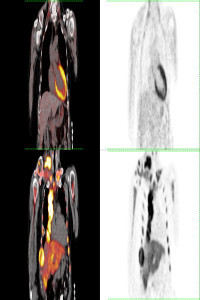Abdominal Mass shown by the FDG PET/CT with diagnosis of Burkitt Lymphoma
Abdominal Mass shown by the FDG PET/CT with diagnosis of Burkitt Lymphoma
Positron emission tomography/computed tomography (PET/CT) with 18F-fluorodeoxyglucose (18F-FDG) is currently a standard imaging examination used in clinical practice, and plays an essential role in preoperative systemic evaluation and tumor staging in various cancer patients. With this method, it is possible to measure or compare metabolic changes in cancer cells. With combined PET/CT, it is possible to determine the correct anatomical location in hypermetabolic tumors with uptake of FDG. In this review, we presented the a case with disseminated abdominal mass diagnosed as Burkitt Lymphoma diagnosed by FDG-PET-CT
___
- 1. Sachpekidis, C., Exadaktylou, P., Katsampoukas, D., Moralidis, E., & Arsos, G. (2020). 18F-FDG PET/CT in treatment response evaluation of Burkitt lymphoma: complete remission of a peritoneal super scan. Hellenic journal of nuclear medicine, 23(1), 76–78. https://doi.org/10.1967/s002449912006
- 2. Zeng, W., Lechowicz, M. J., Winton, E., Cho, S. M., Galt, J. R., & Halkar, R. (2009). Spectrum of FDG PET/CT findings in Burkitt lymphoma. Clinical nuclear medicine, 34(6), 355–358. https://doi.org/10.1097/RLU.0b013e3181a34552
- 3. Wang, X., Chen, Z., Tang, G., & Zhang, X. (2011). A child with Burkitt lymphoma with pleural, peritoneal, mesenteric, omental, and renal involvement: diagnostics by FDG PET/CT. Clinical nuclear medicine, 36(7), 612–615. https://doi.org/10.1097/RLU.0b013e318217af84
- Başlangıç: 2021
- Yayıncı: Mersin Üniversitesi
Sayıdaki Diğer Makaleler
Zehra Pınar KOÇ, Pınar Pelin ÖZCAN, Nurdan ORUÇOĞLU, Hamide SAYAR
Abdominal Mass shown by the FDG PET/CT with diagnosis of Burkitt Lymphoma
Gökçe YAVAN, Zehra Pınar KOÇ, Pınar Pelin ÖZCAN
Zehra Pınar KOÇ, Pınar Pelin ÖZCAN, Emel SEZER, Ahmet DAĞ, Ferah TUNCEL DALOĞLU, Tolgay Tuyan İLHAN
Pınar Pelin ÖZCAN, Zehra Pınar KOÇ, Vehbi ERÇOLAK, Zeynep Selcan SAĞLAM, Gökçe YAVAN, Murat BOZLU, Mesut TEK, Erdem AKBAY
